- Kenmore refrigerator water filters
- Whirlpool refrigerator water filters
- Samsung refrigerator water filters
- GE refrigerator water filters
- LG refrigerator water filters
- Frigidaire refrigerator water filters
- KitchenAid refrigerator water filters
- Maytag refrigerator water filters
- Kenmore Elite refrigerator water filters
- Estate refrigerator water filters
- GE Profile refrigerator water filters
- Amana refrigerator water filters
- Bosch refrigerator water filters
- Dacor refrigerator water filters
- Electrolux refrigerator water filters
Refrigerator: Why won't my refrigerator cool at all?
If your refrigerator's not cold enough, first check whether containers are blocking air flow at the vents; the owner's manual usually shows where the vents are.
High temperatures are also a sign of a control system problem, a bad thermistor, a failure in the air control damper, low refrigerant charge and other malfunctions. Check out the following videos for expert advice on resolving refrigerator cooling issues.

THESE REPAIRS MAY HELP SOLVE YOUR REFRIGERATOR PROBLEM
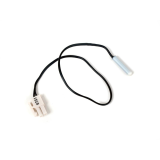
Replace the refrigerator thermistor
If the refrigerator is not cooling enough, the thermistor might be faulty. The thermistor sends temperature information to the thermostat, so a broken thermistor will give bad information.
Refrigerator thermistor
Find the required part specific to your product.
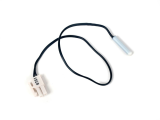
How to replace a refrigerator thermistor
If your refrigerator isn't keeping the temperature you set, the problem could be the thermistor, which senses the temperature. This DIY repair guide shows how to easily replace the thermistor in 15 minutes.
Repair difficulty
Time required
15 minutes or less
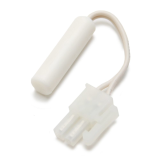
How to replace the thermistor in a top-freezer refrigerator
Is your refrigerator too cold or not cold enough? The thermistor might not be reading the temperatures correctly. This DIY repair guide and video give easy-to-follow instructions on how to replace the thermistor in a top-freezer refrigerator in just 6 steps.
Repair difficulty
Time required
15 minutes or less

Replace the refrigerator condenser fan
The condenser fan is in the machine compartment of the refrigerator next to the compressor. It moves air across the condenser coils to help cool the hot refrigerant coming out of the compressor. The refrigerant is cooled before it moves through the expansion device and into the evaporator. If the condenser fan is defective, replace it.
Refrigerator condenser fan
Find the required part specific to your product.
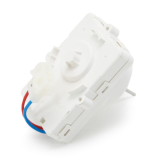
How to replace the condenser fan motor in a top-freezer refrigerator
Does your refrigerator seem warmer than it should? The problem could be the condenser fan motor. This DIY repair guide and video show how to easily replace a failed condenser fan motor in a top-freezer refrigerator in just 6 steps.
Repair difficulty
Time required
15 minutes or less
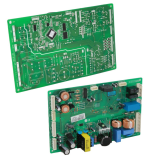
Replace the refrigerator electronic control board
The electronic control board-also called the main control board or the power control board (PCB)-controls the compressor and the defrost cycle. When it senses that the compressor must run to keep the refrigerator cool, it sends voltage to the compressor and fans. The electronic control board also receives signals from temperature sensors to monitor the temperatures inside the refrigerator and freezer. With this information, the electronic control board controls the defrost cycle. You can usually do a diagnostic test on the electronic control board to see how well it's working. The test varies by model, but the most common is the Forced Defrost test. See the tech sheet for instructions on running the diagnostics. Replace the electronic control board if it's not working correctly.
Refrigerator electronic control board
Find the required part specific to your product.

How to replace an electronic control board on the back of a refrigerator
If the control panel lights or fans in your side-by-side, top-mount or bottom-freezer refrigerator aren't coming on, it could mean the electronic control board has failed. This DIY repair guide shows how to replace a faulty refrigerator electronic control board in 7 quick steps.
Repair difficulty
Time required
15 minutes or less
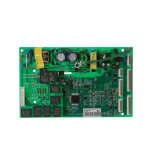
How to replace the electronic control board inside a top-freezer refrigerator
If your refrigerator won't cool at all, the electronic control board may be faulty. This DIY repair guide and video show how to easily replace the electronic control board, and it usually takes only 15 minutes or less.
Repair difficulty
Time required
15 minutes or less
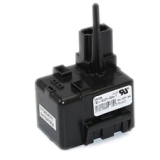
Replace the refrigerator compressor start relay
The start relay—also called the PTC relay—is the electrical device that jump starts the compressor motor. The compressor motor won’t start without the extra starting current from the start relay.
If the start relay isn’t working, you’ll often hear the compressor clicking and humming briefly every few minutes. To verify that the problem is the start relay, unplug the refrigerator, remove the start relay and shake it. If the start relay rattles, replace the start relay.
Refrigerator compressor start relay
Find the required part specific to your product.

How to replace the compressor start relay in a top-freezer refrigerator
If you never hear the hum of your refrigerator's compressor anymore and your food is warming up, the problem might be a failed compressor start relay. This DIY repair guide and video show how to replace the compressor start relay in just 6 easy steps.
Repair difficulty
Time required
15 minutes or less
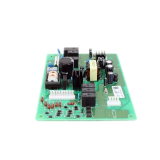
Replace the refrigerator temperature control board
The temperature control board-also called the electronic control board-is in the machine compartment next to the compressor, behind a panel on the back of the refrigerator. The temperature control board controls the compressor and other major components in the refrigerator. You can test it using the diagnostic test procedures provided in the tech sheet for the refrigerator. Replace the temperature control board if it doesn't work at all or isn't controlling the components correctly.
Refrigerator temperature control board
Find the required part specific to your product.
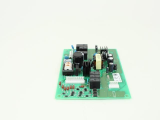
How to replace a refrigerator temperature control board
If a refrigerator is colder or warmer than the temperature you set, the temperature control board might be the problem. This DIY repair guide gives step-by-step instructions to replace the temperature control board in 30 minutes or less.
Repair difficulty
Time required
30 minutes or less
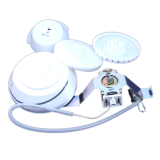
Replace the refrigerator temperature control thermostat
The temperature control thermostat is also called the cold control or cold control thermostat, and is located in the control housing. The thermostat has a sensor tube attached to it that detects the temperature inside the refrigerator cabinet. The temperature control thermostat controls the temperature inside the cabinet by turning on and shutting off the compressor based on the temperature sensed by the sensor tube. Replace the temperature control thermostat if it fails to sense temperature properly or if it does not cycle the compressor properly.
Refrigerator temperature control thermostat
Find the required part specific to your product.
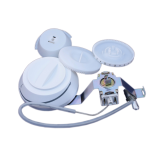
How to replace a refrigerator temperature control thermostat
Is your refrigerator is too cold or too warm? The temperature control thermostat could be to blame. This DIY repair guide gives step-by-step instructions for refrigerator temperature control replacement in 30 minutes or less.
Repair difficulty
Time required
15 minutes or less
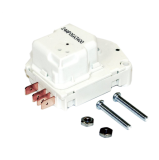
Replace the refrigerator defrost timer
The defrost timer is an electro-mechanical device that controls the intervals between automatic defrost cycles in the refrigerator. The defrost timer motor runs and moves the control components in the device. When the control contacts in the defrost timer advance into the defrost cycle, the compressor stops and the defrost heater turns on for a specified period of time to melt frost off of the evaporator fins. This promotes more efficient exchange of heat across the evaporator. When the specified period of defrost ends, the defrost timer contacts switch back to allow normal cooling operation in the refrigerator.
You'll need to replace the defrost timer if it doesn't advance when activated.
Faulty contacts in the timer can also cause the defrost heater to either not energize at all or constantly energize. In that instance, replace the defrost timer.
Refrigerator defrost timer
Find the required part specific to your product.
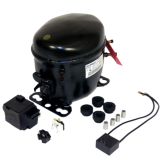
Replace the refrigerator compressor
Repairing the compressor in the refrigerator usually involves the replacement of the start device and/or overload on the motor. If the compressor looks to be in working order but will not start, then replace the start device and/or overload. If the compressor is locked up, or it runs but will not compress the refrigerant, then replace the compressor. A refrigerator service technician will need to complete this repair since it involves the recovery and recharge of the refrigerant.
Refrigerator compressor
Find the required part specific to your product.
Most common symptoms to help you fix your refrigerators
Choose a symptom to see related refrigerator repairs.
Main causes: blocked vents, defrost system problems, evaporator fan failure, dirty condenser coils, bad sensors, condens…
Main causes: damaged door seal, faulty defrost sensor or bi-metal thermostat, broken defrost heater, bad defrost timer o…
Main causes: jammed ice cubes, broken ice maker assembly, dirty water filter, kinked water line, bad water valve, freeze…
Main causes: control board or cold control failure, broken compressor start relay, compressor motor failure, defrost tim…
Main causes: leaky door gasket, defrost system failure, evaporator fan not running, dirty condenser coils, condenser fan…
Main causes: blocked air vents, compressor problems, condenser or evaporator fan not working, control system failure, se…
Main causes: water valve leaking, frozen or broken defrost drain tube, overflowing drain pan, cracked water system tubin…
Things to do: clean condenser coils, replace the water filter, clean the interior, adjust doors to prevent air leaks, cl…
Most common repair guides to help fix your refrigerators
These step-by-step repair guides will help you safely fix what’s broken on your refrigerator.
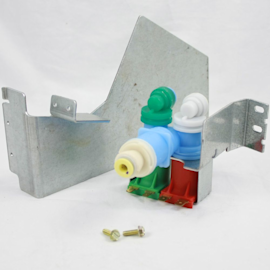
How to replace a refrigerator water valve
Replace the water valve that feeds water to the ice maker and water dispenser if it no longer controls the flow of water…
Repair difficulty
Time required
15 minutes or less

How to clean refrigerator condenser coils
Help your refrigerator run more efficiently by cleaning the condenser coils. It's easy and takes just a few minutes.…
Repair difficulty
Time required
15 minutes or less
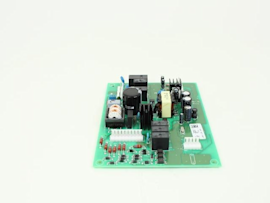
How to replace a refrigerator temperature control board
If the temperature in your refrigerator doesn't match the temperature you set, the problem could be the temperature cont…
Repair difficulty
Time required
30 minutes or less
Effective articles & videos to help repair your refrigerators
Use the advice and tips in these articles and videos to get the most out of your refrigerator.
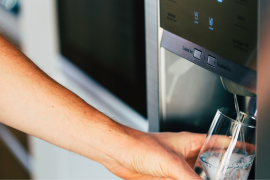
No matter what style Maytag refrigerator you have, we can walk you through replacing the water filter.…

Learn about all the convenient features on our Sears PartsDirect website that make your parts purchases easier.…
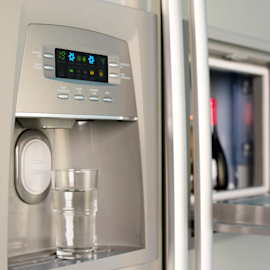
If your refrigerator's ice maker isn't producing as much ice as it should, or water is flowing poorly from the dispenser…
